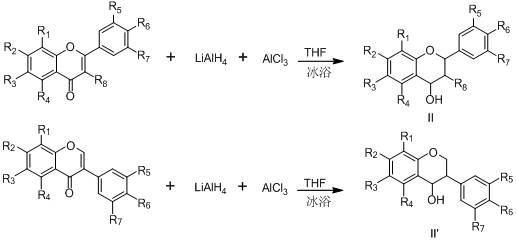Flavanol (isobutene flavanol) urease inhibitor and synthesis and application thereof
A technology of isoflavanol and flavanol, which is applied in the field of preparation of anti-gastritis and gastric ulcer drugs, and can solve problems such as instability and distortion of phosphodiamides
- Summary
- Abstract
- Description
- Claims
- Application Information
AI Technical Summary
Problems solved by technology
Method used
Image
Examples
Embodiment 1
[0061] Example 1: Preparation of 5,7-dihydroxy-4-flavanol
[0062] Dissolve 2.54g chrysin in 80mLTHF, stir magnetically to dissolve chrysin, add LiAlH at room temperature 4 , AlCl 3 (ratio of the amount of substance: chrysin: LiAlH 4 :AlCl 3 =1:7:2), react in ice bath for 5h, add 5M HCl until the pH is between 2-3, add water at the same time, extract with AcOEt, and then saturate NaHCO 3 , washed with saturated brine, anhydrous MgSO 4 Dry and purify by column chromatography on silica gel (200-300 mesh) to obtain 2.35 g of light yellow solid with a yield of 91%. Mp 262-264℃; EIMS m / z: 258 [M + ];IR(KBr)cm -1 :3568(OH); 1 H NMR (DMSO- d 6 ) δppm: 2.59 (dd, 2H), 3.66 (s, 1H), 4.48 (t, 1H), 4.79 (t, 1H), 6.47 (s, 1H), 6.63 (s, 1H), 6.75 (m, 5H ), 7.18 (s, 1H), 7.96 (s, 1H).
Embodiment 2
[0063] Example 2: According to the method similar to Example 1, using flavones (isoflavones) in different substitution forms as raw materials, the flavanols (isoflavanols) listed in Tables 1 and 2 were synthesized 1 ~ 41 .
[0064] Table 1 General formula Ⅱ Each R group of the flavanol in
[0065] serial number R 1 R 2 R 3 R 4 R 5 R 6 R 7 R 8 1 H Oh H H Oh H H H 2 H Oh H Oh Oh H H H 3 H Oh H Oh H Oh Oh Oh 4 H Oh H Oh H H H Oh 5 H Oh Oh H H H H H 6 H Oh Oh Oh H H H H 7 H Oh Oh H H Oh Oh H 8 H Oh Oh H H Oh Oh Oh 9 H Oh Oh H H H Oh H 10 H Oh Oh H H H Oh Oh 11 H Oh Oh H H H H Oh 12 H Oh Oh Oh Oh H H H 13 H Oh Oh Oh Oh H Oh H 14 H Oh Oh Oh Oh H Oh Oh 15 H Oh Oh Oh Oh Oh H H 16 H Oh ...
Embodiment 3
[0068] Embodiment 3: the inhibitory enzyme activity of compound
[0069] Add 25 μL of Jack bean urease (4U) and 25 μL (1 mM) of the test compound solution to the 96-well plate, incubate at 37 °C for 2 h, then add 55 μL of phosphate buffer containing 100 mM urea and 100 mM, Incubate at 30°C for 15 min, add 45 μL of phenol reagent (mixed solution containing 1% phenol and 0.005% sodium nitroprusside) and 70 μL alkali reagent (mixed solution of NaOCl containing 0.5% NaOH and 0.1% active chlorine), and After standing at room temperature for 50 min, measure the OD value at 630 nm with a microplate reader, and the percentage inhibition rate is calculated according to the following formula:
[0070]
[0071] All experiments were performed in solutions at pH 8.2 (0.01M K 2 HPO 4 , 1mM EDTA, 0.01M LiCl), the level of activity is measured by the half-inhibition rate IC 50 to indicate that the IC 50 The smaller the value, the higher the activity of the compound. The results are s...
PUM
 Login to View More
Login to View More Abstract
Description
Claims
Application Information
 Login to View More
Login to View More - R&D
- Intellectual Property
- Life Sciences
- Materials
- Tech Scout
- Unparalleled Data Quality
- Higher Quality Content
- 60% Fewer Hallucinations
Browse by: Latest US Patents, China's latest patents, Technical Efficacy Thesaurus, Application Domain, Technology Topic, Popular Technical Reports.
© 2025 PatSnap. All rights reserved.Legal|Privacy policy|Modern Slavery Act Transparency Statement|Sitemap|About US| Contact US: help@patsnap.com



